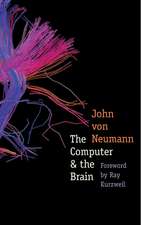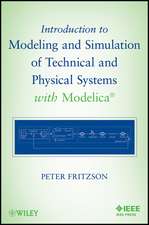Practical Numerical Algorithms for Chaotic Systems
Autor Thomas S. Parker, Leon Chuaen Limba Engleză Paperback – 21 dec 2011
Preț: 392.21 lei
Nou
Puncte Express: 588
Preț estimativ în valută:
75.05€ • 80.25$ • 62.57£
75.05€ • 80.25$ • 62.57£
Carte tipărită la comandă
Livrare economică 18 aprilie-02 mai
Preluare comenzi: 021 569.72.76
Specificații
ISBN-13: 9781461281214
ISBN-10: 1461281210
Pagini: 368
Ilustrații: XIV, 348 p.
Dimensiuni: 155 x 235 x 19 mm
Greutate: 0.51 kg
Ediția:Softcover reprint of the original 1st ed. 1989
Editura: Springer
Colecția Springer
Locul publicării:New York, NY, United States
ISBN-10: 1461281210
Pagini: 368
Ilustrații: XIV, 348 p.
Dimensiuni: 155 x 235 x 19 mm
Greutate: 0.51 kg
Ediția:Softcover reprint of the original 1st ed. 1989
Editura: Springer
Colecția Springer
Locul publicării:New York, NY, United States
Public țintă
ResearchCuprins
1 Steady-State Solutions.- 1.1 Systems.- 1.2 Limit sets.- 1.3 Summary.- 2 Poincaré Maps.- 2.1 Definitions.- 2.2 Limit Sets.- 2.3 Higher-order Poincaré maps.- 2.4 Algorithms.- 2.5 Summary.- 3 Stability.- 3.1 Eigenvalues.- 3.2 Characteristic multipliers.- 3.3 Lyapunov exponents.- 3.4 Algorithms.- 3.5 Summary.- 4 Integration.- 4.1 Types.- 4.2 Integration error.- 4.3 Stiff equations.- 4.4 Practical considerations.- 4.5 Summary.- 5 Locating Limit Sets.- 5.1 Introduction.- 5.2 Equilibrium points.- 5.3 Fixed points.- 5.4 Closed orbits.- 5.5 Periodic solutions.- 5.6 Two-periodic solutions.- 5.7 Chaotic solutions.- 5.8 Summary.- 6 Manifolds.- 6.1 Definitions and theory.- 6.2 Algorithms.- 6.3 Summary.- 7 Dimension.- 7.1 Dimension.- 7.2 Reconstruction.- 7.3 Summary.- 8 Bifurcation Diagrams.- 8.1 Definitions.- 8.2 Algorithms.- 8.3 Summary.- 9 Programming.- 9.1 The user interface.- 9.2 Languages.- 9.3 Library definitions.- 10 Phase Portraits.- 10.1 Trajectories.- 10.2 Limit sets.- 10.3 Basins.- 10.4 Programming tips.- 10.5 Summary.- A The Newton-Raphson Algorithm.- B The Variational Equation.- C Differential Topology.- C.1 Differential topology.- C.2 Structural stability.- D The Poincaré Map.- E One Lyapunov Exponent Vanishes.- F Cantor Sets.- G List of Symbols.













